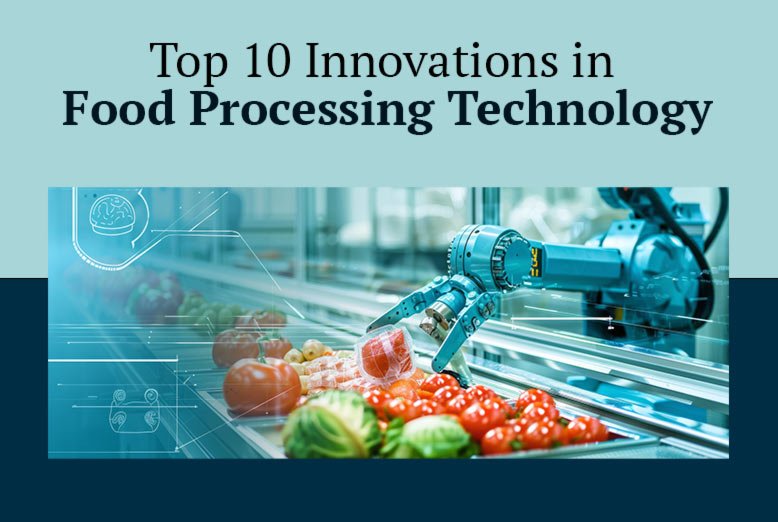Food processing constantly evolves to meet the demands of an ever-growing population while ensuring food safety, quality, and efficiency. However, the sector faces several challenges, including reducing food waste, maintaining product freshness, and meeting consumer demand for healthier, more sustainable products. These pain points have pushed the industry toward adopting innovative technologies that streamline processes and enhance food quality. Today, more advanced technologies are reshaping how food is processed, packaged, and delivered to consumers, making it a dynamic field for innovation. In this article, we’ll explore the top 10 innovations in food processing technology.
1. High-Pressure Processing (HPP)
HPP is a non-thermal technique that uses high-pressure water to destroy harmful microorganisms in food, extending shelf life without the use of preservatives. Unlike traditional heat-based methods, HPP retains the food’s nutritional value and flavor while ensuring safety. This innovation is particularly beneficial for fresh products like juices, meats, and ready-to-eat meals.
2. Wire Mesh in Food Processing
One of the lesser-known yet highly impactful innovations in food processing is the use of wire mesh, which plays a crucial role in improving the quality and efficiency of food handling systems. Wire mesh is used in conveyors, filtration, and food separation processes to ensure consistency and hygiene during food production. Its versatility in baking, drying, and sorting applications makes it a vital component of modern food processing technology. To learn more about its benefits, explore the role of wire mesh in food processing.
3. 3D Food Printing
3D food printing is revolutionizing how we create and consume food. This innovation allows the layering of ingredients to create intricate designs, customized meals, or even entirely new food structures. 3D printing offers precision in ingredient use, reducing waste and providing personalized nutrition, which is especially beneficial in hospitals and specialty diets.
4. Pulsed Electric Fields (PEF)
PEF technology is used to process liquids such as juices and dairy products. PEF destroys pathogens and extends shelf life without compromising nutritional content by applying short bursts of high voltage to food,. This method is more energy-efficient than traditional pasteurization, making it an environmentally friendly option in food processing.
5. Cold Plasma Technology
Cold plasma technology is emerging as a game-changer for sterilization in food processing. It generates reactive gases that can kill bacteria on food surfaces without altering the food’s taste or texture. This technology is especially useful for treating fruits, vegetables, and grains, as it maintains freshness while ensuring food safety.
6. Smart Packaging
Smart packaging uses sensors and indicators to monitor the condition of food, providing real-time information about freshness, temperature, and spoilage. This innovation helps reduce food waste by allowing consumers and retailers to better manage inventory and make informed decisions about product safety. Moreover, some smart packages can extend the shelf life of food by controlling humidity and oxygen levels.
7. Nanotechnology
Nanotechnology in food processing is used to improve the texture, flavor, and nutritional content of food. Nano-encapsulation, for example, can protect sensitive ingredients like vitamins and probiotics from degradation, ensuring they remain effective until consumption. Moreover, nanoparticles can enhance food safety by delivering antimicrobial properties, which help prevent spoilage.
8. Blockchain for Food Traceability
Blockchain technology is being adopted to improve transparency in food supply chains. With a decentralized, tamper-proof record of each step in the production process, blockchain allows companies and consumers to monitor the origin and journey of food products. This increases accountability and ensures that food safety standards are met throughout the supply chain, reducing risks of contamination and fraud.
9. Internet of Things (IoT) in Food Processing
The IoT has found numerous applications in food processing, particularly in improving operational efficiency. IoT-enabled devices can monitor food processing equipment, ensuring optimal performance and reducing downtime. In addition, IoT sensors track storage conditions, such as temperature and humidity, ensuring that food products are stored in ideal conditions from farm to table.
10. Robotic Automation
Robotic automation has transformed various aspects of food processing, from sorting and packing to more delicate tasks like filleting fish or icing cakes. Robots reduce human error, enhance precision, and can operate continuously, boosting overall productivity. In highly automated facilities, robots can handle repetitive tasks, enabling people to focus on more complex activities that require critical thinking.
Conclusion
Advancements in food processing technology are transforming the industry, enhancing efficiency, sustainability, and safety. Innovations like non-thermal sterilization methods, 3D food printing, and blockchain for traceability are solving key challenges. These technologies not only improve food quality and safety but also support a more sustainable production system. As the industry evolves, future breakthroughs will minimize food waste, promote healthier products, and ensure accessibility for businesses of all sizes, creating a more resilient global food system.
Also Read: 10 Types of Foods That Help to Reduce Temperature

















